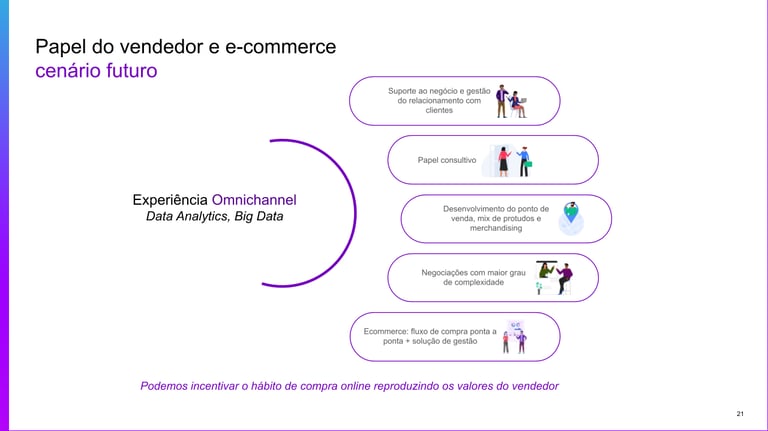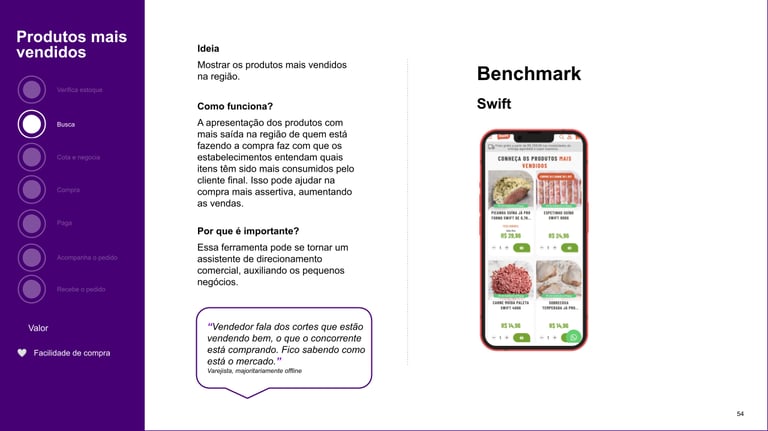Integrated actions to increase online conversion
Challenge
The purpose of the project was to evaluate and propose improvements for the B2B sales website, identifying the factors that made sales through sales representatives outperform those of the digital channel, even though the site offered frequent promotions. The main challenge was to understand both online and in-person purchase journeys, as well as to ensure that the new digital channel would boost sales without harming the performance of the sales team.
My role
Coordination of a multidisciplinary team: I led UX designers, UX writers, accessibility analysts, and visual designers in an analysis of purchase flows.
Heuristic and strategic analysis: I conducted a detailed heuristic evaluation, identifying critical usability, clarity, and information hierarchy issues.
Roadmap definition: I structured the improvement roadmap, prioritizing high-impact actions for the business and for user experience.
Process
I adopted an integrated approach, aligned with best practices, to ensure robust deliverables and actionable insights:
Mapping problems in the purchase flow: The heuristic analysis revealed clarity issues and problems with hierarchy, directly impacting conversion.
Qualitative research and benchmarking: At the same time, a dedicated team conducted benchmarking, interviews with clients and stakeholders, and shadowed sales representatives. We discovered that the lack of a structured guidance channel made it difficult for salespeople to stay updated on promotions and strategies. For clients, accessing the platform was complex, with recurring login issues and lack of support for account recovery. With stakeholders, we learned that site updates were made directly by each product distribution center, in an uncoordinated way.
Behavioral analysis: We identified that most clients were not used to buying online, even with other suppliers. The negative experience was worsened by differences in delivery times and lack of order tracking for purchases made on the site, compared to in-person purchases.
Data-driven prioritization: All findings were organized into an annual action plan, prioritizing improvements that would generate immediate value for both users and the business.
*The company information has been withheld to ensure the protection of confidential data.
In just 4 weeks, we delivered a strategic roadmap, prioritizing improvements in usability, information clarity, and integration between digital and in-person channels. The plan included incremental deliveries each quarter, ensuring continuous improvement for both buyers’ and sellers’ experiences.
Despite schedule adjustments due to cost cuts, the plan was followed and expanded to 18 months, maintaining a focus on consistent online purchases and efficient order tracking.
Results




Challenge
The purpose of the project was to evaluate and propose improvements for the B2B sales website, identifying the factors that made sales through sales representatives outperform those of the digital channel, even though the site offered frequent promotions. The main challenge was to understand both online and in-person purchase journeys, as well as to ensure that the new digital channel would boost sales without harming the performance of the sales team.
My role
Coordination of a multidisciplinary team: I led UX designers, UX writers, accessibility analysts, and visual designers in an analysis of purchase flows.
Heuristic and strategic analysis: I conducted a detailed heuristic evaluation, identifying critical usability, clarity, and information hierarchy issues.
Roadmap definition: I structured the improvement roadmap, prioritizing high-impact actions for the business and for user experience.
Process
I adopted an integrated approach, aligned with best practices, to ensure robust deliverables and actionable insights:
Mapping problems in the purchase flow: The heuristic analysis revealed clarity issues and problems with hierarchy, directly impacting conversion.
Qualitative research and benchmarking: At the same time, a dedicated team conducted benchmarking, interviews with clients and stakeholders, and shadowed sales representatives. We discovered that the lack of a structured guidance channel made it difficult for salespeople to stay updated on promotions and strategies. For clients, accessing the platform was complex, with recurring login issues and lack of support for account recovery. With stakeholders, we learned that site updates were made directly by each product distribution center, in an uncoordinated way.
Behavioral analysis: We identified that most clients were not used to buying online, even with other suppliers. The negative experience was worsened by differences in delivery times and lack of order tracking for purchases made on the site, compared to in-person purchases.
Data-driven prioritization: All findings were organized into an annual action plan, prioritizing improvements that would generate immediate value for both users and the business.
*The company information has been withheld to ensure the protection of confidential data.
In just 4 weeks, we delivered a strategic roadmap, prioritizing improvements in usability, information clarity, and integration between digital and in-person channels. The plan included incremental deliveries each quarter, ensuring continuous improvement for both buyers’ and sellers’ experiences.
Despite schedule adjustments due to cost cuts, the plan was followed and expanded to 18 months, maintaining a focus on consistent online purchases and efficient order tracking.
Results




